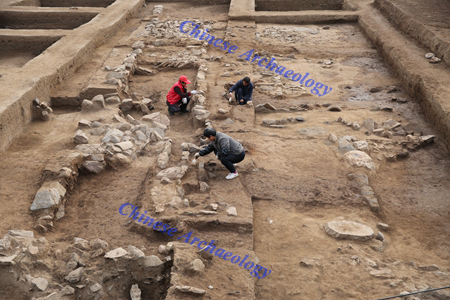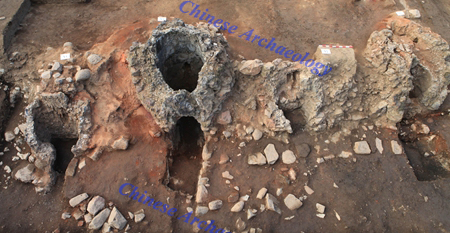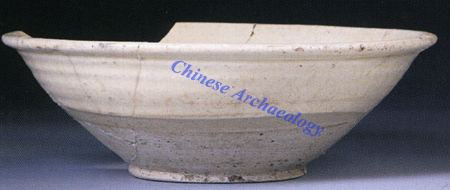Mining site cluster found at Dazhuangke, Beijing
From:Chinese Archaeology NetWriter:Date:2015-04-10
The Dazhuangke mining site cluster is located at the Dazhuangke village, Yanqing County, which is 70 km away from the Beijing city.During the October, 2011 to November 2014, the Institute of Cultural Relics at Beijing, cooperated with the Beijing Technology University and the Beijing University, conducted the archaeological excavation at the sites.
The Dakezhuang site cluster is composed of mining deposit (iron ore quarries), smelting venue, residential remains and workshop. The archaeological evidence provides rich information on the procedure of metallurgical operation and the life of mining workers.

the excavation of Liao Dynasty mining site is underway at Dazhuangke, Beijing
The number of iron smelting furnaces found at the Dazhuangke site ranks at the top among all such remains belonging to the Liao Dynasty. The furnaces there are preserved in good condition whose shape could be clearly distinguished. The inner structures of furnaces remain well, the air blower of which can be easily identified. This discovery of furnace reflects the history of development of blast furnace in the ancient China.
The mining site including the mine cave along with part of the open-air mine deposit where the iron mineral was mined, is situated around the hill foot. The river system surrounding it was well developed, which ensured the transporting of the mineral.

furnace remains for smelting iron found at Dazhuangke site, Beijing
There have been 10 iron smelting furnaces so far found at the Dazhuangke site, all of which are shaft furnaces. The middle part of the furnace is slightly outward and the intersection of it is roughly round. They are composed of stove, stove door, iron outlet, waste outlet, blaster blower and the front and the back process surfaces. The air blower is located at the middle of the back wall while the stove door is at the bottom of the furnace, the two of which are facing to each other. The liquid iron drainage was discovered underneath the stove door. The front surface was used for operating the iron smelting as well as storage of pig iron products. The back surface though is preserved relatively worse, its function can still be roughly identified as storage of fuel and mineral. The procedures of breaking and sieving of fuel and mineral were also conducted on the back surface before mineral and fuel were poured into the furnace.

unearthed furnace remains for mining process at Dazhuangke, Beijing
There are three dwelling structures and workshops within the site cluster. The Qingshuiquan site of living structures and workshops is located to the northeast of the smelting site. There were mineral ore, iron fragments, furnace waste, iron arrowheads, iron knives and stone grindings found in the site. The architecture materials include stone slate, gray ceramic tiles, tile ends decorated with beast face, bricks carved with strippers and so forth. Daily items include ceramic bowls, jar coated with dark yellow enamel, pottery jar, ink-slab, copper coins, weaving tools and so on.

unearthed white porcelain bowl from Dazhuangke site, Beijing
Dwelling houses are located in the north but facing south, most of which are composed of yard gate, main house, and wing-rooms to the east and west, and the evidence of treaded surface are obvious. They were mainly built upon the ground surface. The main house is centered in courtyard, whose wall foundation was constructed by stones. The upper part of the house, which has been destroyed, was originally covered with grey clay tiles. The door is in the south, which is paved with rectangular stone threshold. There is a stepping floor found within the house which was hard and intense and contained burning earth and ash. The kang (Chinese heated bed) was found at the northwest part of the house whose slab is covered with a layer of clay. There is smoke outlet within the kang and the kang surface is covered with granite slab. A group of chimneys sits in the northwest corner.

unearthed iron knife from Dazhuangke site, Beijing
The workshop location yielded traces of chariots and remnants of paved roads. There are totally 10 lines of traces of chariots recovered. All those routes are in north-south direction, extending from the Shuiquangou smelting site in the south to the Hanjiachuan smelting location in the north.

unearthed tile-end decorated with beast face
The Dazhuangke site cluster is located adjacent to the south capital of the Liao kingdom, which also was the frontier of the battlefield between Song and Liao kingdoms. Dazhuangke, on one hand, might have produced weapons for military use. On the other hand, it could also have been an important place for spreading the metallurgic technology from the central plain. As recorded in the history, the West Liao Kingdom, rising from the remnants of the Liao kingdom performed as one of the powerful roles in spreading the technology of cast ironworking to the west.
On balance, the Dazhuangke mining site cluster renders valuable archaeological evidences about the study into the iron-working history in the ancient China. (Translator: Dong Ningning)

